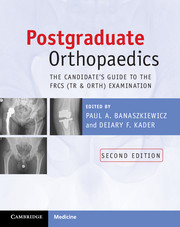Book contents
- Frontmatter
- Contents
- Contributors
- Foreword
- Preface to second edition
- Abbreviations
- Section 1 The FRCS (Tr & Orth) examination
- Section 2 The written paper
- Section 3 The clinicals
- Section 4 The adult elective orthopaedics oral
- Chapter 12 General structured oral exam guidance
- Chapter 13 Shoulder and elbow oral core topics
- Chapter 14 Hip oral core topics
- Chapter 15 Knee oral core topics
- Chapter 16 Foot and ankle oral core topics
- Chapter 17 Spine oral core topics
- Chapter 18 Orthopaedic oncology oral core topics
- Section 5 The hand oral
- Section 6 The paediatric oral
- Section 7 The trauma oral
- Section 8 The basic science oral
- Section 9 Miscellaneous topics
- Index
- References
Chapter 13 - Shoulder and elbow oral core topics
from Section 4 - The adult elective orthopaedics oral
- Frontmatter
- Contents
- Contributors
- Foreword
- Preface to second edition
- Abbreviations
- Section 1 The FRCS (Tr & Orth) examination
- Section 2 The written paper
- Section 3 The clinicals
- Section 4 The adult elective orthopaedics oral
- Chapter 12 General structured oral exam guidance
- Chapter 13 Shoulder and elbow oral core topics
- Chapter 14 Hip oral core topics
- Chapter 15 Knee oral core topics
- Chapter 16 Foot and ankle oral core topics
- Chapter 17 Spine oral core topics
- Chapter 18 Orthopaedic oncology oral core topics
- Section 5 The hand oral
- Section 6 The paediatric oral
- Section 7 The trauma oral
- Section 8 The basic science oral
- Section 9 Miscellaneous topics
- Index
- References
Summary
Anatomy of shoulder
The shoulder girdle is formed by the scapula, clavicle and proximal humerus. They form three synovial joints (glenohumeral, acromioclavicular and sternoclavicular) and two articulations (scapulothoracic and acromiohumeral).
The glenohumeral joint (GHJ), being the most mobile joint in the body, relies on static and dynamic stabilizers to remain centred. Static stabilizers are the glenoid labrum, the capsule/ligaments and negative pressure. The capsular ligaments tighten differentially according to the degree of elevation. In the midrange of motion (most activities of daily living) most capsules are lax and stability is contributed mainly by dynamic stabilizers. Anterior ligaments oppose anterior humeral translation in external rotation. Posterior ligaments oppose posterior humeral translation in internal rotation. The superior glenohumeral ligament opposes inferior translation in the adducted shoulder. The middle glenohumeral ligament opposes anteroinferior translation in the midrange of movement. The inferior glenohumeral ligament opposes anterior translation in higher degrees of abduction.
- Type
- Chapter
- Information
- Postgraduate OrthopaedicsThe Candidate's Guide to the FRCS (Tr and Orth) Examination, pp. 151 - 169Publisher: Cambridge University PressPrint publication year: 2012



